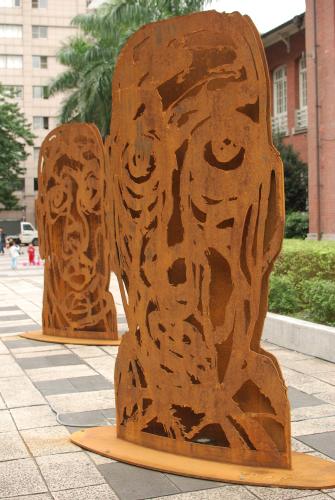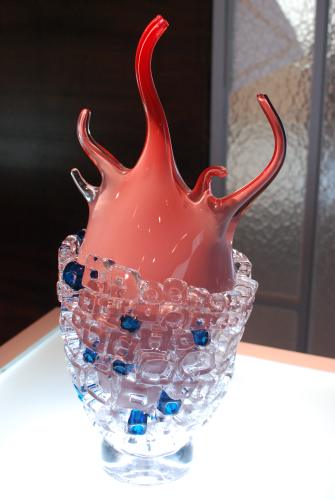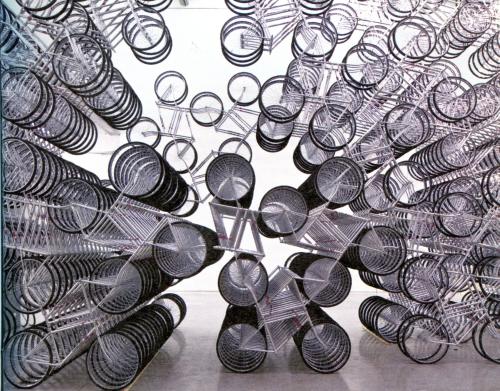Museums of Taipei
I did the rounds of the museums in Taipei on Saturday. I’m lucky in that the Museum of Contemporary Art (MOCA) is only a couple of blocks away. I can walk there in three or four minutes. The Taipei Fine Arts Museum is also nearby. Finally, I went to the Tittot Glass Art Museum. It was my first visit to this museum.
I started off, as I usually do, with a cup of coffee. I still haven’t found the perfect coffee shop in my neighborhood. Starbucks is unreliable. You never know if the coffee is going to be hot or not. It can be crowded. And the Starbucks beside my apartment is not very nice. It has a terrible atmosphere and design. Most neighborhood coffee shops don’t open until around noon. I’m generally looking for a coffee shop first thing in the morning, and Taipei doesn’t really get going on the weekend until noon.
[slickr-flickr tag=”MOCA & Tittot & TFAM” type=”gallery” align=”center” sort=”date”]About the only option left to me is 85 degrees. This is a Taiwanese coffee shop chain and they make good coffee. It’s pretty much always hot and the prices are about half or a third of the prices at Starbucks. That makes it a good choice. There are some problems, though. The biggest problem for me is the room temperature. These coffee shops are often open to the world. They aren’t sealed. They have outdoor seating and then just an open wall leading to the inside. I generally don’t like to sit outside – especially in Taipei where it is either too hot or too cold, too wet or too noisy, or too windy or crowded. The inside is often air conditioned, but with the open wall, it doesn’t have much of an effect and it is just too hot. At least, it’s too hot for me, and I can’t get comfortable. The search for a neighborhood coffee shop goes on.
85 degrees is right beside MOCA and after I had my coffee, I went to the museum. It wasn’t a great day for MOCA, but I still enjoyed myself. It wasn’t a great day because they were between main exhibits. The last one, Fashionista, had just left, and the new one was still being installed. So, essentially, the museum was closed. There was, however, a small exhibit open. It was housed in a small space to the right, which is generally always open and free to the public to visit.
The exhibit was Beyond Calligraphy by Taiwanese Artist Hsu Yung-Chin. His art is a fusion of contemporary art with traditional calligraphy. A large red sculpture outside the museum is one of his. It is about six feet tall and quite striking with the fire-engine red color and the Chinese characters all mashed together. Inside, there are some traditional paintings using calligraphy with a modern twist. The work I enjoyed most, though, was a video installation. The piece is called Taiwan Dream and is projected on three huge screens each about the size of a wall. Apparently all kinds of sophisticated computer technology was used to create it. I enjoyed sitting there in the cool dark and watching the calligraphy flow over the screen and listening to the music. The music was Taichi drum music from the U Theater Group. I was never a big fan of video art in the past, but I always enjoy the video pieces at MOCA, probably because it’s such a pleasure to escape from the heat of Taipei and sit in an ice-cold dark room.
After my visit to MOCA, I hopped on the MRT and rode many stops north to the Guandu MRT station. The Tittot Glass Art Museum is located just a couple of blocks away from this MRT station. It was a rough-and-ready sort of place that could use some landscaping, some cleaning, and a couple coats of paint. It’s also in a pretty rundown neighborhood, and I thought at first I was in the wrong place. The entrance fee was a modest NT$100.
There were four or five rooms of pieces of glass art on two floors plus a DIY area where you can learn to work with glass yourself and a gift shop. I suppose I found it interesting enough. There were a few beautiful pieces. There was also a big display of the history of glass art in China. The most interesting thing for me was, in fact, another video display. This was on a TV set into the wall and you could sit on a bench and watch as some glass artisans made a beautiful glass creation. This video, more than anything at the museum, gave me an insight into glass and how artists work with it. It’s an extraordinary thing and watching them work was hypnotizing. At a certain level, I think we are all aware of the fragility of glass and I ended up sitting on the edge of my seat with worry that the artist would drop the glass or otherwise break it. There were a couple of times when the other people watching the video with me gasped when there was a sudden movement. It was actually quite tense. I wish I could remember what the artists created. It was the recreation of some kind of a famous cup. It was the kind of video that is probably shown on the Learning Channel six times a day, so I hardly needed to go to this museum to see it. However, it made the trip more interesting and helped me appreciate the art in the museum.
The Tittot Glass Art Museum was a bit smaller than I had expected, so when I left I still had one museum visit left in me and I stopped off at the Taipei Fine Arts Museum. That was easily done since it is near the Yuanshan MRT station, and I could just hop off there and walk across the old Flora Exposition grounds. There is always something going on there, and this time there was a display of chrysanthemums. You’d think the flower display was put on specifically so that the budding photographers of Taiwan would have something to take pictures of. I’ve never seen so many expensive cameras in my life as I have in the last year or so in Taiwan. Taiwan has become the land of photographers. I wonder how that started.
The Taipei Fine Arts Museum is a wonderful place. It’s open and airy and always has interesting exhibits. It’s also very laidback. The entrance fee for normal exhibits is NT$30. There were two main exhibits that I hadn’t seen before. One was a set of works by Chinese artist Ai Weiwei. The other was a photographic exhibition by one of Taiwan’s classic photographers, Huang, Tse-Hsiu. I guess that Huang, Tse-Hsiu and the Shutter Trio are the grand old masters of photography in Taiwan. A display by the Shutter Trio is currently showing at the Futai Street Museum downtown.
As soon as I went through the front doors, I was confronted by 12 giant animal heads made out of brass. Some of these were quite scary and others were comical, and I happily took some pictures. In the lobby, you’re allowed to take pictures. You can’t take pictures inside the museum as far as I know. These brass heads were a piece by Ai Weiwei called Circle of Animals. The piece has all kinds of significance and meaning, all of which is clearly explained in the detailed booklet you get there. No need to repeat it here. The heads just struck me as pretty imposing things and quite fun. They’re worth checking out.
Ai Weiwei is apparently an artist with many interests. He pretty much does it all from sculpture to photography. He was born in China in 1957 and spent quite a few years living in New York’s East Village. When he returned to China, he created the Beijing equivalent of the East Village. Overall, I find his art something that I can take or leave. I liked the big brass animal heads. The rest seemed to be art that has to be explained – like a whole bunch of Qing Dynasty stools stuck together in a shape supposed to be like a bunch of grapes. I guess it looked cool, but it sort of falls into that category of art where I figure any high school art student could have done the same thing. There were a couple of tables that were twisted in a surrealistic way so that the table legs were touching both the floor and the wall. Again, it’s cool, but it’s something that any art student might do on a weekend. I guess you’re supposed to read the booklet to find out why this art is deep and meaningful and all that.
That isn’t to say there wasn’t pleasure to be had in looking at them. Ai Weiwei certainly doesn’t hold back when it comes to scale. There was a piece made up of tables and old wooden beams from a temple. It towers over you and fills a very large space. I liked that piece. And, of course, there was the centerpiece of the exhibit – a 10-meter-high sculpture made up of more than 1,000 identical bicycles. That was kind of funky, I have to admit. Then again, I didn’t appreciate it as art so much as a technical feat. I couldn’t help but wonder how this piece gets shipped around the world and how it is dismantled and packed and then reassembled somewhere else. Overall, the exhibit is well worth a visit.
The photography exhibit by Huang, Tse-Hsiu was called “The Photographic Journey of a Maverick.” Huang is now 82 years old and has been taking pictures in Taiwan for most of his life. I can’t say, however, that I was particularly moved by his photographs. They didn’t seem technically that impressive to me. Nor did the subject matter seem that interesting. I got the impression that his photography was new and revolutionary at the time he was taking his pictures. He was taking pictures of ordinary things from day-to-day life when the trend at the time was to take staged shots. Today, however, they seem somewhat ordinary. In fact, the most interesting thing about his pictures was how many of them I have taken myself. I’ve recently gone on quite a few trips around Taiwan and the Taipei area and I’ve taken a lot of pictures. They are the typical pictures one would take – rock formations at Yehliu Geopark, Longshan Temple, and Taroko Gorge. On display by Huang were these exact same pictures except that they were in black and white and had been taken fifty or sixty years ago.
It could be that I didn’t really appreciate the photography because I was a bit tired by that point after already visiting two museums. I was also just tired in general not having slept well the night before. It might be worthwhile to go back a second time and give them a second chance. Huang did have a number of pictures that serve as a record of a Taiwan that is now gone – for example, the traditional villages of the aboriginal groups. Still, there was something about even those pictures that struck me as quite ordinary. They looked like typical tourist pictures, maybe even taken for a postcard. Anyway, I’ll have to go back and go through again a bit slower. I’m sure there was more there of interest than I saw.
It had been an okay day of culture, and I ended it with a great cup of coffee and a brownie at the coffee shop in the basement of the museum. I finally got my good coffee experience.
Tags: Ai Weiwei, MOCA, museum, Taipei, Taipei Fine Arts Museum, Taiwan, Taiwan Dream




